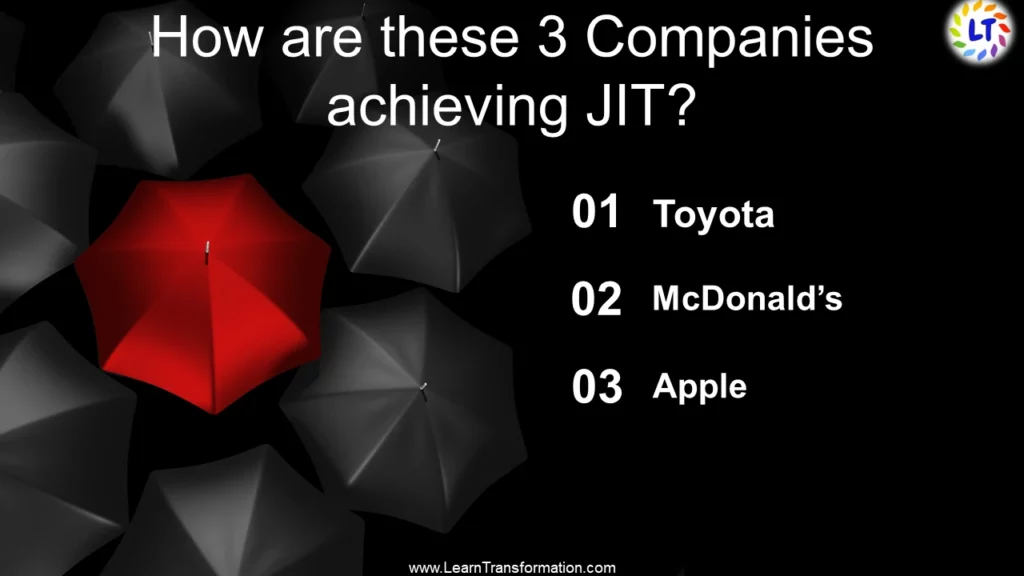“Supply Chain is like nature; it is all around us”
Dave Waters
Revolutionizing Production: How Toyota, McDonald’s, and Apple Achieve Incredible Efficiency with Just-In-Time (JIT) Methodology
Just-in-time is a movement that has attained huge acceptance in the business community over the past decade. Its manufacturing is a well approach for management of inventory. It is manufacturing is a production model based on the Toyota Production System, used to eliminate waste and in which business owners produce products once a customer has requested & paid for it, not created in excess or in advance of need.
- Revolutionizing Production: How Toyota, McDonald’s, and Apple Achieve Incredible Efficiency with Just-In-Time (JIT) Methodology
- What is Just-in-Time (JIT)?
- Objective of Just in time (JIT)
- Elements of Just In Time(JIT)
- Companies Practicing Just In Time (JIT) Successfully
- Toyota
- McDonald’s
- Apple
- What are the benefits of Just In Time(JIT)?
- How does JIT reduce waste?
- What are the disadvantages of JIT?
What is Just-in-Time (JIT)?
The notion of producing the right units in the right quantities at the right time is the short term Just-in-time (JIT). In JIT method, the company retains as much inventory as it requires during the production and transformation process, which in turn saves the storage cost & insurance.
Strong implementation is dependent on creating a business wide initiative, motivating staff engagement and formulating a policy and strategy that can be mobilized.
Click here to Get Famous Book on Just In Time:
P.J. O’Grady
Putting the Just-In-Time Philosophy into Practice
Objective of Just in time (JIT)
- The main objective of JIT strategy is for right inventories across the organization & its supply chain.
- JIT production reduces the waste related with waiting, overproduction & excess inventory which are 3 of the 8 waste categories as in the Toyota Production System.
- The extensive acquisition of just-in-time (JIT) inventory principles doubtlessly makes production operations more systematic, customer responsive & cost effective.
- Many business owners use this inventory method to boost efficiency and reduce waste, which reduces inventory stock costs. This method, therefore, requires manufacturers to predict demand precisely to be effective.
Elements of Just In Time(JIT)
- Set-up Time
An efficient Just in Time System environment basically needs reduced setup time. Reduced setup time offers the capability to react quickly to customer orders & decreases the demand for safety stocks.
- Plant Layout
Just in Time System provides improved plant layout. In conventional layouts, all of the machinery of a comparable class are bring together in same physical location. For instance, all of the granulation machines are in one location & all of the compression machines in another.
- Flexible Workforce
Workers should be multitalented in a Just in Time Inventory System environment. Which is often organized into small “cells” that contain all of the equipment needed to perform several steps in the production process. Workers should have the knowledge of using all of the various pieces of equipment in the work cell.
- Defect Rates
JIT technology offers lower defect rates.

Traditionally, inventory of finished goods was regarded assets. But this belief has changed owing to JIT & now inventory is regarded as waste or unlucrative, sustaining extra costs.
Also Read: Supply Chain 4.0-Revolutionize Your Supply Chain Management
Companies Practicing Just In Time (JIT) Successfully
Toyota
Toyota was the first to implement JIT system efficiently.
Factors Pertaining to Toyota’s Success-
- They keep small batches of raw material at every production station, which makes sure that there is always sufficient inventory stock to begin production of any product.
- Precise forecasting to stock raw materials at the correct levels.
McDonald’s
In the food & beverage industry, it’s useful to implement a JIT inventory system as finished products for human consumption have a lifetime after which they are worthless. McDonald’s presented what this system looks like in the real world where they have components onsite for the immediate future. Although nothing is make until a consumer places an order. So with this process, whenever a customer gets an order, they feel the same consistent experience.
Best Video for you:
Factors Pertaining to McDonald’s Success-
- Standardized procedures ensuring consistency.
- JIT method boosts customers satisfaction as items are made more freshly.
- JIT inventory system helps business owners save money and decrease wastage, while still providing their customers with the products they want & need in a timely manner.
Apple
Tech company Apple has utilized JIT principles to make its manufacturing process a success. Their motivation was not just reducing waste & associated costs but also to reduce energy consumption. How did they do it? They develope reliable & trustworthy relationships with their suppliers so that they could order stock with far shorter preparation times with the assurance orders will meet. Furthermore, Apple began to take advantage of drop shipping where products are shippe directly from the manufacturer to the customer, cutting out ‘middlemen’ and therefore reducing shipping & storage costs.
Factors Pertaining to Apple’s Success-
- Stocking inventory at their retail stores.
- A willingness of suppliers to keep inventory on hand permitting Apple to be free of this responsibility.
- Drop shipping arrangements for online purchases.
What industries are most suited for JIT?
Industries that produce high volumes of standardized products, such as automotive manufacturing, electronics, and consumer goods uses JIT.
Hand-picked for you:How 8 wastes elimination can improve efficiency by 200%.
Leader’s Tip:
In order to guarantee the timely and dependable supply of materials and components, forge solid ties with suppliers.
What are the benefits of Just In Time(JIT)?
Just-in-Time (JIT) is a lean manufacturing strategy that aims to produce products only when needed, in the exact quantity required, and at the right time. Here are some of the benefits of JIT:
Reduced inventory costs: JIT helps to minimize inventory holding costs by producing goods only when they need them, reducing the amount of inventory held in storage.
Improved quality: JIT emphasizes on producing products in small batches, which allows for quicker identification and resolution of defects. This results in a reduction of the cost of quality.
Increased efficiency: JIT eliminates the need for long production runs and setups, which increases the efficiency of the manufacturing process. It also reduces lead times, which allows for quicker response to changes in demand.
Better supplier relationships: JIT requires close collaboration between suppliers and manufacturers, resulting in stronger relationships and increased supplier performance.
Reduced waste: JIT helps to eliminate waste by producing only what is in need, reducing excess inventory, and minimizing defects.
Increased flexibility: JIT allows for the production of small quantities of a product, which enables companies to quickly respond to changes in customer demand.
Improved cash flow: JIT reduces the need for large inventories, freeing up cash that ensures another invsetment in other areas of the business.
Overall, JIT can help companies improve their competitiveness by reducing costs, increasing efficiency, improving quality, and enhancing customer satisfaction. However, JIT also requires careful planning and execution, as it relies heavily on coordination between suppliers, manufacturers, and customers.
How does JIT reduce waste?
Just-in-Time (JIT) is a lean manufacturing strategy that aims to produce products only when needed, in the exact quantity required, and at the right time. One of the main benefits of JIT is that it helps to reduce waste in the production process. Here are some ways that JIT reduces waste:
Reducing overproduction: JIT helps to eliminate overproduction, which is one of the main causes of waste in the manufacturing process. By producing only what is in need, JIT reduces the amount of excess inventory that is produce. Which can lead to waste in the form of storage costs, obsolescence, and damage.
Minimizing waiting time: JIT aims to eliminate waiting time by ensuring that each process in the production line is synchronize with the next process. This helps to minimize the amount of time that products spend waiting in inventory, which reduces the risk of damage and obsolescence.
Reducing defects: JIT emphasizes on producing products in small batches, which allows for quicker identification and resolution of defects. This helps to minimize the amount of waste that is generated due to rework or scrap.
Eliminating excess inventory: JIT requires a high degree of coordination between suppliers and manufacturers. It ensures that inventory is delivered in the right quantity and at the right time. By eliminating excess inventory, JIT reduces the amount of waste that is generated due to storage costs, obsolescence, and damage.
Streamlining production processes: JIT requires a high level of standardization and consistency in production processes. By streamlining production processes, JIT reduces the amount of waste that is generated due to process inefficiencies, errors, and delays.
Overall, JIT helps to reduce waste by ensuring that products are produced only when needed. In the exact quantity required, and at the right time. This helps to minimize excess inventory, waiting time, defects, and other forms of waste that can lead to increased costs and reduced efficiency.
Also check:35 Best Leadership Books of All Time
What are the disadvantages of JIT?
While JIT can offer many benefits to a company, there are also several potential disadvantages that need to be considered,
Supply Chain Disruptions: JIT is vulnerable to supply chain disruptions, as any delays or issues with suppliers can quickly impact production schedules.
Quality Issues: JIT relies on a high degree of coordination and consistency in the production process. Which can be challenging to achieve. Any quality issues with raw materials, components, or finished products can quickly impact the entire production process.
Increased Reliance on Suppliers: JIT requires close coordination with suppliers. And any issues with the supplier can impact the entire production process.
Reduced Flexibility: JIT relies on a highly optimized production process, which can reduce flexibility in the face of changes in demand, supply chain disruptions, or other issues.
Increased Costs: JIT requires a high degree of coordination, which can increase costs associated with production planning and supply chain management.
Overall, while JIT can offer many benefits, companies need to carefully consider the potential risks and drawbacks before implementing the strategy.
It’s important to weigh the potential benefits of JIT against these potential disadvantages and determine whether the strategy is appropriate for the company’s specific needs and goals. Companies must also have contingency plans in place to mitigate potential risks and disruptions.
Leader’s Tip:
To optimise production schedules and inventory levels, put in place reliable demand forecasting and monitoring systems.
Final Word
Companies effectively implementing JIT principles as a key part of #supplychaintransformation have considerable competitive advantages over competitors that have not. The move is riddling out how to apply JIT principles to attain competitive advantages in your particular industry & business situation.
Frequently Asked Questions
What are the benefits of JIT?
JIT offers several benefits, including reduced inventory costs, improved efficiency, higher quality products, reduced waste, and improved customer satisfaction.
What are the potential drawbacks of JIT?
JIT requires a high degree of coordination between suppliers and manufacturers, which can be challenging to achieve. JIT can also be vulnerable to supply chain disruptions and quality issues
How is JIT implemented?
JIT is implemented by optimizing the production process to eliminate waste, reducing lead times, and streamlining the supply chain to ensure that inventory is delivered on time and in the right quantity.
How does JIT differ from traditional manufacturing?
Traditional manufacturing often involves producing large quantities of products in anticipation of demand, which can result in excess inventory and waste. JIT, on the other hand, aims to produce products only when needed, in the exact quantity required, and at the right time.
Key Takeaways
- JIT improves cash flow and customer responsiveness while lowering carrying costs, storage needs, and waste.
- For the JIT implementation to be successful, all stakeholders must effectively communicate and coordinate.
- JIT demands an effective and well-designed production process, dependable logistics, and a continuous improvement mentality.

